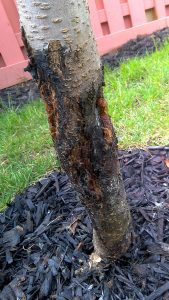
Hello, would you please help me to heal my poor peach tree? It produces an excellent harvest and is only 4 years old. Two years ago everything started with a very small sore. Now this tree is literally bleeding. The trunk became very thin and resembles a piece of plywood. It’s hardly a fungus, I tried everything I could to eliminate the fungus. The black colour is the tree paint, which I bought at CanTire. Help me to save my tree, please.
It is sad to see a young tree in this condition, particularly when it has given you an abundance of delicious fruit. From the photo, I suspect the tree is suffering from a canker, caused either by a fungus or a bacterium.
Peach canker is caused by the fungi Cytospora leucostoma and Cytospora cincta. These fungi attack a tree made vulnerable by winter damage, mechanical wounds or insect damage. The first sign is oozing of gum (gummosis) near the infected sight in spring. The bark sinks under the gum, forming a depressed area. It dies, then hardens during the summer when the fungus is inactive. Cooler weather causes the fungus to reactivate and enlarge the canker. In later years, the bark breaks and becomes disfigured. Eventually the process may girdle branches and tree trunks.
Bacterial canker is caused by the bacterium, Pseudomonas syringe. Infections can occur any time the weather is wet and cold. It is spread by wind, water and infected pruning tools. I am sorry to say there is no reliable cure for this condition. Only in the early stages can the cankers be removed using a sharp, sterile knife. To read more about this disease consult the following:
https://plantclinic.cornell.edu/factsheets/cytosporacankerfruit.pdf
https://ohioline.osu.edu/factsheet/plpath-fru-25
https://homeguides.sfgate.com/cure-cytospora-canker-peach-trees-35430.html
I would suggest you contact a certified arborist in order to make a definitive diagnosis. They will also be able to inform you of your options regarding treatment or, worst case scenario, removal of the tree. If you don’t know an arborist, Landscape Ontario should be able to help you find a certified professional in your area – see link below:
In the meantime, it would be a good idea to clean up all debris (leaves, twigs etc…) from your entire garden so that infection can be minimized. Do not put this debris in a home composter, send it out to be processed by your local municipality. Also, all tools should be sterilized between plant use – see the link below for easy ways to do this:
https://gardeningsolutions.ifas.ufl.edu/care/tools-and-equipment/disinfecting-tools.html

